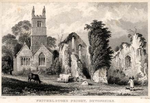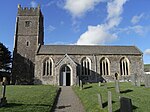Watergate Halt railway station
1925 establishments in England1965 disestablishments in EnglandBeeching closures in EnglandDisused railway stations in DevonFormer Southern Railway (UK) stations ... and 6 more
Pages with no open date in Infobox stationRailway stations in Great Britain closed in 1965Railway stations in Great Britain opened in 1926South West England railway station stubsTorridge DistrictUse British English from March 2017

Watergate Halt was an intermediate halt on the initially privately run North Devon and Cornwall Junction Light Railway. "It was one of those moments you always remember – a first glimpse, caught through the dappled sunlight of a woodland glade. Deep within the heart of North Devon, I came across this tiny wayside halt, no longer than a single carriage length." A remote rural station with one small siding used by a local farmer, it was closed in 1965 and now forms part of the popular Tarka trail, a route for ramblers promoted by the local council.
Excerpt from the Wikipedia article Watergate Halt railway station (License: CC BY-SA 3.0, Authors, Images).Watergate Halt railway station
Watergate Bridge, Torridge District Frithelstock
Geographical coordinates (GPS) Address External links Nearby Places Show on map
Geographical coordinates (GPS)
| Latitude | Longitude |
|---|---|
| N 50.9377 ° | E -4.1808 ° |
Address
Watergate Halt
Watergate Bridge
EX38 8PA Torridge District, Frithelstock
England, United Kingdom
Open on Google Maps










